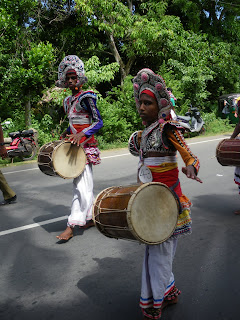The lifestyle in Sri Lanka is pretty laidback most of the time. Even the driving, which seems chaotic at first, seems to just happen without many rules and little stress or fuss. Despite continuous overtaking, regardless of corners, hills or overtaking vehicles approaching, there seems to be a lot fewer accidents than one feels there should be. This could be because the maximum speed seems to be 40mph, but the driving, as with life, seems to flow easily.
There are many holidays in Sri Lanka too, not just the official ones, but it seems plausible for people to take a couple of days off around the official holidays to go visit family or religious places or even just for personal business.
And there are many public holidays. Poya days are the most common sites for these. A poya day is the day of the full moon and signifies the advent of significant religious occasions. Whilst here, I have been lucky enough to take part in two of the more important poya days in the Sri Lankan calendar: Wesak Poya, and Posson Poya.
Wesak Poya celebrates the birth, enlightenment and death of Buddha. These events are all believed to have occurred on the May full moon. The festival is a mixture of Christmas and Easter rolled together and is very important for Sri Lankan Buddhists. This is a festival of light, lanterns are made from bamboo and hung around the outside of the house along with fairy lights and candles. The towns and cities are also decorated and there can be mini festivals with bands and stalls.
Devout Buddhists visit the temple every day in the week leading up to Wesak Poya and offerings of drinks, food, flowers, and alms for the monks are laid in front of the statues of Buddha. There are processions with the Buddhist flag that take these offerings to the temple and the flags are to be found adorning roadsides and shops all over the county.
The same is true of Posson Poya, although this festival is not as big. It is a celebration of the introduction of Buddhism into Sri Lanka. There are no lanterns for this one, but there are still celebrations… and dansals…
A dansal is a stall found along the roadside that offers free food and drink to passers by. This can range from a simple as a cup of tea or ice cream to a full blown curry meal. Often there are boys with flags waving down cars, buses and pedestrians. Loud music blasts from giant sound systems and the stalls are decorated with flowers and colour. Dansals and alms-giving is all part of building up the good karma. Good deeds increase good karma which is weighed against the bad karma from bad deeds to determine the fate of the next rebirth. A dansal must vastly increase the good karma through random acts of generosity!
The Poya day celebrations can also include a Pera Hera or two. These are carnivals that parade through the villages and showcase a slice of Sri Lankan culture. They usually seem to begin with flower-bicycles parading up and down the road, followed by whip-crackers that announce the arrival of the procession. What follows is a succession of dancers, drummers, bands, and devils that pass in waves of colour and sound. I’m not sure on the story of each section but if I do find out I will be sure to report back! This week I have been able to see two Pera Heras, here are some of the best photos…








































